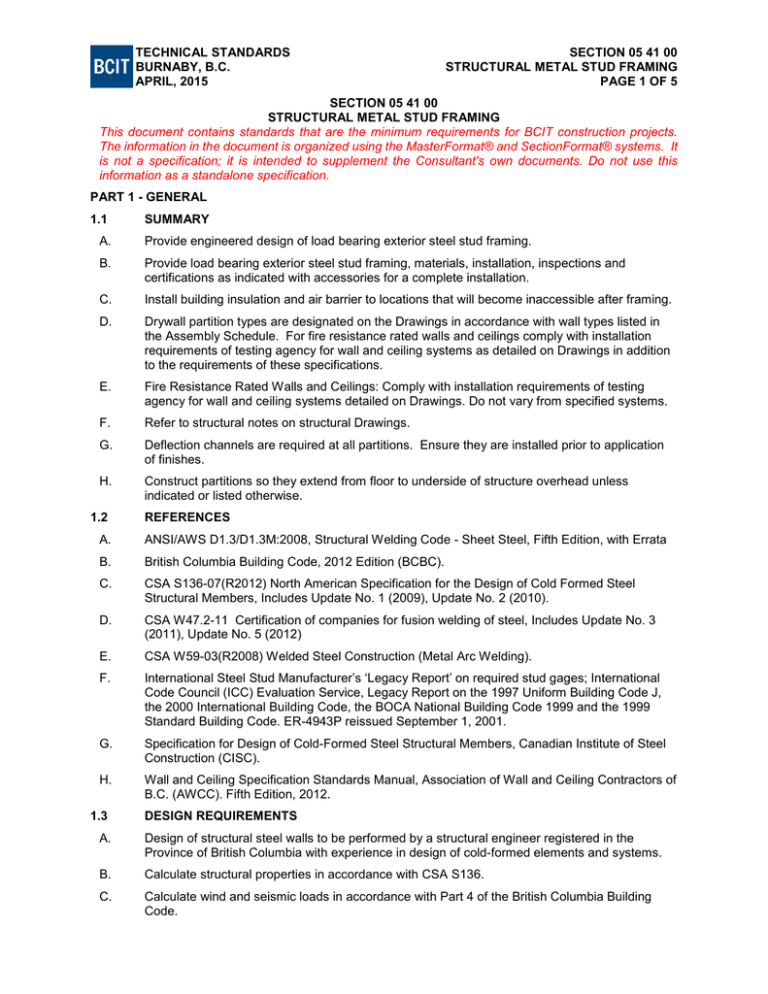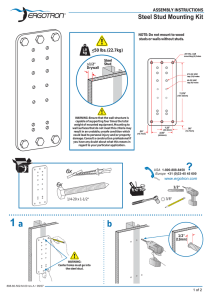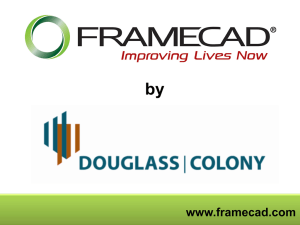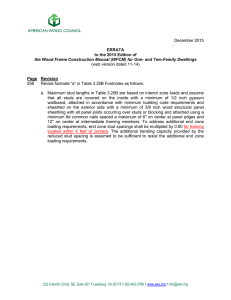Division 05 - Metals
advertisement

TECHNICAL STANDARDS BURNABY, B.C. APRIL, 2015 SECTION 05 41 00 STRUCTURAL METAL STUD FRAMING PAGE 1 OF 5 SECTION 05 41 00 STRUCTURAL METAL STUD FRAMING This document contains standards that are the minimum requirements for BCIT construction projects. The information in the document is organized using the MasterFormat® and SectionFormat® systems. It is not a specification; it is intended to supplement the Consultant's own documents. Do not use this information as a standalone specification. PART 1 - GENERAL 1.1 SUMMARY A. Provide engineered design of load bearing exterior steel stud framing. B. Provide load bearing exterior steel stud framing, materials, installation, inspections and certifications as indicated with accessories for a complete installation. C. Install building insulation and air barrier to locations that will become inaccessible after framing. D. Drywall partition types are designated on the Drawings in accordance with wall types listed in the Assembly Schedule. For fire resistance rated walls and ceilings comply with installation requirements of testing agency for wall and ceiling systems as detailed on Drawings in addition to the requirements of these specifications. E. Fire Resistance Rated Walls and Ceilings: Comply with installation requirements of testing agency for wall and ceiling systems detailed on Drawings. Do not vary from specified systems. F. Refer to structural notes on structural Drawings. G. Deflection channels are required at all partitions. Ensure they are installed prior to application of finishes. H. Construct partitions so they extend from floor to underside of structure overhead unless indicated or listed otherwise. 1.2 REFERENCES A. ANSI/AWS D1.3/D1.3M:2008, Structural Welding Code - Sheet Steel, Fifth Edition, with Errata B. British Columbia Building Code, 2012 Edition (BCBC). C. CSA S136-07(R2012) North American Specification for the Design of Cold Formed Steel Structural Members, Includes Update No. 1 (2009), Update No. 2 (2010). D. CSA W47.2-11 Certification of companies for fusion welding of steel, Includes Update No. 3 (2011), Update No. 5 (2012) E. CSA W59-03(R2008) Welded Steel Construction (Metal Arc Welding). F. International Steel Stud Manufacturer’s ‘Legacy Report’ on required stud gages; International Code Council (ICC) Evaluation Service, Legacy Report on the 1997 Uniform Building Code J, the 2000 International Building Code, the BOCA National Building Code 1999 and the 1999 Standard Building Code. ER-4943P reissued September 1, 2001. G. Specification for Design of Cold-Formed Steel Structural Members, Canadian Institute of Steel Construction (CISC). H. Wall and Ceiling Specification Standards Manual, Association of Wall and Ceiling Contractors of B.C. (AWCC). Fifth Edition, 2012. 1.3 DESIGN REQUIREMENTS A. Design of structural steel walls to be performed by a structural engineer registered in the Province of British Columbia with experience in design of cold-formed elements and systems. B. Calculate structural properties in accordance with CSA S136. C. Calculate wind and seismic loads in accordance with Part 4 of the British Columbia Building Code. TECHNICAL STANDARDS BURNABY, B.C. APRIL, 2015 SECTION 05 41 00 STRUCTURAL METAL STUD FRAMING PAGE 2 OF 5 D. Limit maximum deflection under specified wind loads to L/720 for walls with ceramic tile or masonry veneer finishes and L/360 for other walls. E. Space members not to exceed 400 mm (16 in.) on centre. F. Required depth of steel studs is shown on Drawings. Do not use other sizes unless approved by Consultant. G. Design components to accommodate specified erection tolerances of the structure. H. Design wind bearing stud end connections to accommodate floor/roof deflections and to ensure that studs are not loaded axially. 1. Wind Pressure: a. 2. Load bearing steel stud systems shall be designed by the specialty structural engineer of the supplier for the wind pressures identified in the structural notes on the structural Drawings. Differential Movement For Cladding Design: a. Ensure deflection gaps are incorporated into the design and construction of the steel stud systems. Refer to structural notes: 1) Vertical Movement Between 2 Floors: 2) Horizontal Displacement between Floors I. Connect steel framing members by bolts, welding, or sheet metal screws. J. Design steel studs to take into to account the anchorage of other materials being supported including but not limited to finishes and the provision of lateral support at window heads and sills. K. Design steel studs to support equipment where detailed. Obtain design loads from equipment supplier. L. Partitions shall extend from floor to the underside of structure overhead unless indicated and/or listed otherwise. 1.4 SUBMITTALS A. Submit in accordance with Section 01 33 00 Submittal Procedures. B. Product Data: Submit manufacturer’s product data, information and installation instructions for each item of framing and accessories. C. Shop Drawings: 1. Shop Drawings shall be signed and sealed by a Structural Engineer licensed to practice in the Province of British Columbia. Engineer to provide Letters of Assurance indicating compliance with B.C. Building Code. 2. Layout diagrams for setting anchor bolts. 3. Shop details indicating sizes, cuts and connections of all members. 4. Indicate locations for required cross bracing where specified in ULC wall rating types. 5. Submit manufacturer’s details that comply with ULC ratings and indicate where each detail will be installed. Do not vary from assemblies specified. 6. Connections to concrete, steel and other structures abutting and supporting the steel stud work. 7. Indicate minimum gauge of studs at the following locations: a. Minimum gauge at walls higher than one storey. b. Minimum gauge at walls with finish of cement board and or tile assembly. TECHNICAL STANDARDS BURNABY, B.C. APRIL, 2015 c. D. SECTION 05 41 00 STRUCTURAL METAL STUD FRAMING PAGE 3 OF 5 Minimum gauge at walls with millwork or equipment mounted directly to stud framing. Letters of Assurance: Engineer who seals Shop Drawings will submit Schedules S-B and S-C to the Certified Registered Professional (CRP): 1. At initial Shop Drawing Submission: a. 2. After Completion of Field Reviews: a. 3. Submit Schedule S-B, “Assurance of Professional Design and Commitment for Field Review.” Submit Schedule S-C, “Assurance of Professional Field Review and Compliance.” Submit written inspection reports of field reviews to Consultant within five (5) working days after completion of each site inspection made to confirm compliance of steel stud work with reviewed Shop Drawings. E. Samples: Submit samples of framing components and fasteners to Consultant if requested. F. Reports: Submit two (2) certified copies of mill reports covering chemical and mechanical properties, and coating designation of steel used in this work. 1.5 QUALITY ASSURANCE A. Installer Qualifications: Company specializing in heavy gauge steel stud work with proven experience for projects of similar size and complexity. B. Manufacturer Qualifications: Use products and materials from same source for entire project. C. Companies Engaged in Welding: Certified by the Canadian Welding Bureau to CSA W47.1 and welders qualified for the base material and procedures to be executed. PART 2 - PRODUCTS 2.1 MATERIALS A. General: Minimum gauges shall be in accordance with the design included in the sealed Shop Drawings. B. Steel: Sheet steel to ASTM A924. C. Zinc Coating: Studs, track, and components to be hot-dipped galvanized with a coating conforming to Z275. D. Welding Materials: To CSA W59. E. Screws: #8 or heavier, 11 mm dia. pan head, self-drilling, case hardened, self-tapping sheet metal screws, 0.008 mm coating of zinc or cadmium plating. Screw length equal to thickness of materials penetrated plus not less than 12 mm (1/2 in.) penetration of the stud. Use not less than 10 mm (3/8 in.) pan head self drilling, self tapping screws for fastening studs to track. F. Anchors: Concrete expansion anchors or other suitable drilled type fasteners, as selected by the steel stud design engineer. G. Bolts, Nuts, Washers: Hot dipped galvanized to CSA G164, 600 g/m 2 zinc coating. H. Touch-up Primer: Zinc rich, to CGSB 1-GP-181M. I. Insulation for Deflection Channel: Refer to Section 07 21 00 Building Insulation. J. Steel Studs: 1. To CSA S-136, fabricated from zinc coated steel, depth as indicated. 2. No stud shall be less than 1.092 mm base metal thickness (43 mil, 18 gauge), 1.150 mm design thickness unless indicated otherwise on sealed Shop Drawings. Thicker material may be required to satisfy structural requirements. TECHNICAL STANDARDS BURNABY, B.C. APRIL, 2015 SECTION 05 41 00 STRUCTURAL METAL STUD FRAMING PAGE 4 OF 5 3. Studs carrying cement board or any tile assembly shall be minimum 1.372 mm base steel thickness (54 mil, 16 gauge),1.444 mm design thickness unless indicated otherwise on sealed Shop Drawings. 4. Studs carrying attached millwork or other equipment loads shall be of minimum gauge specified for this purpose on sealed Shop Drawings. K. Steel Stud Tracks: Fabricated from same material and finish as steel studs, depth to suit. L. Bridging: Fabricated from same material and finish as studs, 38 x 12 mm, 1.22 mm minimum thickness (1-1/2 x 1/2 in., 0.047 in. minimum thickness.) M. Angle clips: Fabricated from same material and finish as studs, 38 x 38 mm x depth of steel stud, 1.22 mm minimum thickness (1-1/2 x 1-1/2 in x depth of steel stud, 0.047 in minimum thickness). PART 3 - EXECUTION 3.1 A. 3.2 EXAMINATION Examine work of other trades with Installer present. Correct unsatisfactory conditions. Verify that surfaces and conditions are ready to accept the work of this section. Start of installation means acceptance of existing conditions. PREPARATION A. Review Shop Drawings and carefully note where rated separations are required. B. Ensure cross bracing and other construction details required per specific ULC wall types, horizontal and vertical shafts, and double stud wall assemblies are noted and adhered to. C. Deflection channels are required at all partitions. Ensure they are installed prior to application of finishes. 3.3 ERECTION A. Erect work in accordance with, AWCC standards, reviewed Shop Drawings, Code requirements and manufacturer’s printed instructions. Where in conflict, follow more stringent requirements. B. Fire Resistance Rated Walls: Construct fire rated assemblies exactly as indicated to comply with Code requirements. Place vertical joints over studs. Comply with requirements of testing agency for rated assemblies detailed on Drawings. C. Box-in and gasket electrical, telephone and TV outlets in fire rated partitions with drywall, typical. Seal for Environmental Tobacco Smoke (ETS) control as specified in Section 07 84 00 Fire Stopping and Smoke Seals and Section 07 92 00 Joint Sealants. D. Anchor tracks securely to the structure at 800 mm (32 in.) on centre max., unless lesser spacing prescribed on engineered Shop Drawings. E. Erect studs plumb, aligned and securely attach with not less than one No. 8 screw or weld at each side of flange of top and bottom tracks. F. Seat studs into top and bottom tracks. G. Allow deflection spaces between drywall partitions and building structural framing components to allow for movement of framing components. H. Deflection Head: 1. Deflection channels are required at all partitions. Install 50 mm (2 in.) minimum deflection channel at top of walls where required to accommodate vertical deflection. 2. Nest top track into deflection channel a minimum of 25 mm (1 in.) and a maximum of 38 mm (1-1/2 in.), unless indicated otherwise on Drawings. 3. Do not fasten tracks together. 4. Install insulation in deflection channel. TECHNICAL STANDARDS BURNABY, B.C. APRIL, 2015 SECTION 05 41 00 STRUCTURAL METAL STUD FRAMING PAGE 5 OF 5 I. Install studs at not more than 50 mm (2 in.) from abutting walls, openings, and each side of corners and terminations with dissimilar materials. J. Bridging: 1. Unless engineering design for steel stud wall assembly provides for lateral stiffening by means other than internal bridging, brace steel studs with horizontal internal bridging at 1500 mm (60 in.) on centre maximum. Fasten bridging to 1.52 mm (0.06 in.) steel clips fastened to steel studs with four (4) No. 8 screws or by welding. Touch-up welded areas with coat of galvanized paint. 2. Provide cross bracing or bridging where specified in the ULC listings for rated assemblies including rated double stud wall assemblies. K. Frame openings in stud walls to adequately carry loads by use of additional framing members and bracing as detailed on Shop Drawings. L. Provide 1.22 mm (0.05 in.) sheet metal backing in walls for anchoring and mounting equipment, grab bars, or other items, not supplied with backing attachments. Fasten equipment, fittings and anchors to blocking or backing in partitions. M. 3.4 A. 3.5 1. Penetrate sheet metal screws a minimum of three (3) exposed threads beyond joined materials. 2. Perform welding in accordance with CSA W59 and/or ANSI/AWS D1.3 as applicable. 3. Touchup welds with coat of zinc rich primer. Frame both sides of control and expansion joints independently and do not bridge joints with furring, framing, or accessories. RATED ASSEMBLIES Install rated assemblies in accordance with ULC listed assemblies. Do not vary from the design unless an alternate assembly is approved in writing by the Consultant. ERECTION TOLERANCES A. Plumb: Not to exceed 1/500th of the member length. B. Camber: Not to exceed 1/1000th of the member length. C. Spacing: Not more than 3 mm (1/8 in.) from design spacing. D. Gap between End of Stud and Track Web: Not more than 3 mm (1/8 in.), except where required to accommodate deflection. 3.6 A. B. CUTOUTS Limit unreinforced cut-outs for services to the following dimensions: Member Depth Across Member Depth Along Member Length Spacing O.C. 89 mm (3-1/2 in.) 38 mm (1-1/2 in.) 100 mm (4 in.) 600 mm (24 in.) >150 mm (>6 in.) 64 mm (2-1/2 in.) 115 mm (4-1/2 in.) 600 mm (24 in.) Limit distance from centerline of last unreinforced cutout to end of member to less than 305 mm (12 in.). END OF SECTION



